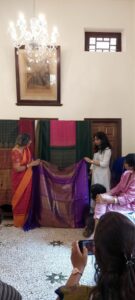A recently held event threw light on the fascinating aspects of Cubbonpet saris, woven centuries ago in the alleys of Cubbonpet.

Textile expert Pavithra Muddaya recently held a talk on Cubbonpet saris, in association with INTACH Bengaluru Chapter. (Supplied)
On a breezy Saturday morning with skies threatening to pour, I found myself making an unusual trip to Cubbonpet. I had nothing to shop for in Cubbonpet, which is one of Bengaluru’s oldest commercial districts. The well-known Karaga festival that takes place in Cubbonpet every year is already over. So what was it that made me shake off my slumber on a weekend? It needed to be remarkable, which it was.
In the run up to National Handloom Day, observed on 7 August, a talk by textile expert Pavithra Muddaya on Cubbonpet saris, held in association with Indian National Trust for Art and Cultural Heritage (INTACH) Bengaluru Chapter, was simply irresistible.
So there I was, in a 100-year-old heritage house in Cubbonpet, amidst a motley group that comprised architects, textile connoisseurs, and heritage lovers.
It was a full house, where some of us sat on the floor and listened intently to Muddaya discussing the subtleties of a sari known as the Cubbonpet sari.
Until three decades ago, Muddaya wasn’t aware of the Cubbonpet sari. The story goes back to when she met a weaver to reproduce what she understood as a Kanjeevaram sari. He told her that he was reminded of his father in Cubbonpet weaving a similar pattern.
Eighty-two-year-old weaver Puttana Shetty was overwhelmed to see the sari. He informed the group that he was around eight years old when he saw his father weaving similar patterns on his Cubbonpet handloom.
“I didn’t know that this kind of weaving was done in Bengaluru. Because I thought it was Kanjeevaram, and was shocked,” says Muddaya, who is a co-founder of Vimor. A third-generation family-run heritage saree store, Vimor works with handlooms and has been reviving designs for 45 years.
“Cubbonpet used to be a hub of handloom weavers, but then the authorities moved them to the outskirts of the city, promising free electricity. Later, Cubbonpet became the hub for powerlooms, and there are many in the area even today,” said Meera Iyer, Convenor, the INTACH-Bangalore chapter, at the talk.
As Muddaya guided us deeper into the world of Cubbonpet saris, the powerlooms, which are still on their premises, rumbled on.
Her exchange with the weaver nudged her to research the obscure sari often misinterpreted as Kanjeevarams. The research unravelled many interesting facts about it. One such was that it is woven with a three-shuttle interlocking technique.
“It’s interesting to note that motifs in a Cubbonpet sari start in the body itself before moving to the pallu. Another distinguished feature is that while it has checks on the front, you will find stripes at the back. It is a very labour-intensive sari,” explains Muddaya.
The motifs are unlike Kanjeevaram.
“They have a distinctive style. The elephant and Gajalakshmi are comparable. You come upon Gandaberunda (two-headed bird form of Lord Vishnu), which serves as the government of Karnataka’s official symbol. It connects the body and pallu. Two rows of patterns resembling rudraksha are used in the plain border. The weaving technique is fabulous. It’s a binary system based on the jacquard loom,” details Muddaya.
The elaborate motifs and ornateness of the sari suggest that they were meant for special occasions.

A Cubbonpet sari features a line of designs before the main pallu begins, as is customary for the Cubbonpet. (Supplied)
Vimor has revived the weave and created three limited edition versions of the sari in pure silk and zari. There is a Cubbonpet Palm Tree Deep pink which has a smaller border as opposed to the typical broad borders of a Cubbonpet sari.
The checks were replaced with butta. Palm tree motifs are found on the pallu along with the Gandaberunda. Vimor developed an original Cubbonpet sari with Triple Kattam Cubbonpet Rani, which features a large pallu, triple checks, and a broad border. The body’s checks, which come in three different weaves, are woven using the ettu kolu technique.
Along with the Gandaberunda, the big pallu, which measures almost one metre, includes exceedingly stylised decorations. The saree features a line of designs before the main pallu begins, as is customary for the Cubbonpet.
The heritage sari store also worked on another experimental sari — Ivory Stripes Cubbonpet Pallu, with a smaller border. The checks have been replaced with stripes.
Muddaya brought some of these saris along with an old, restored turquoise green with dark blue pallu Cubbonpet sari, to the talk. The audience was transported back in time by Muddaya’s storytelling as she stood beneath a glass chandelier hanging from the high ceiling of the century-old home.

Jul 26, 2024

Jul 26, 2024

Jul 26, 2024

Jul 26, 2024

Jul 26, 2024

Jul 25, 2024